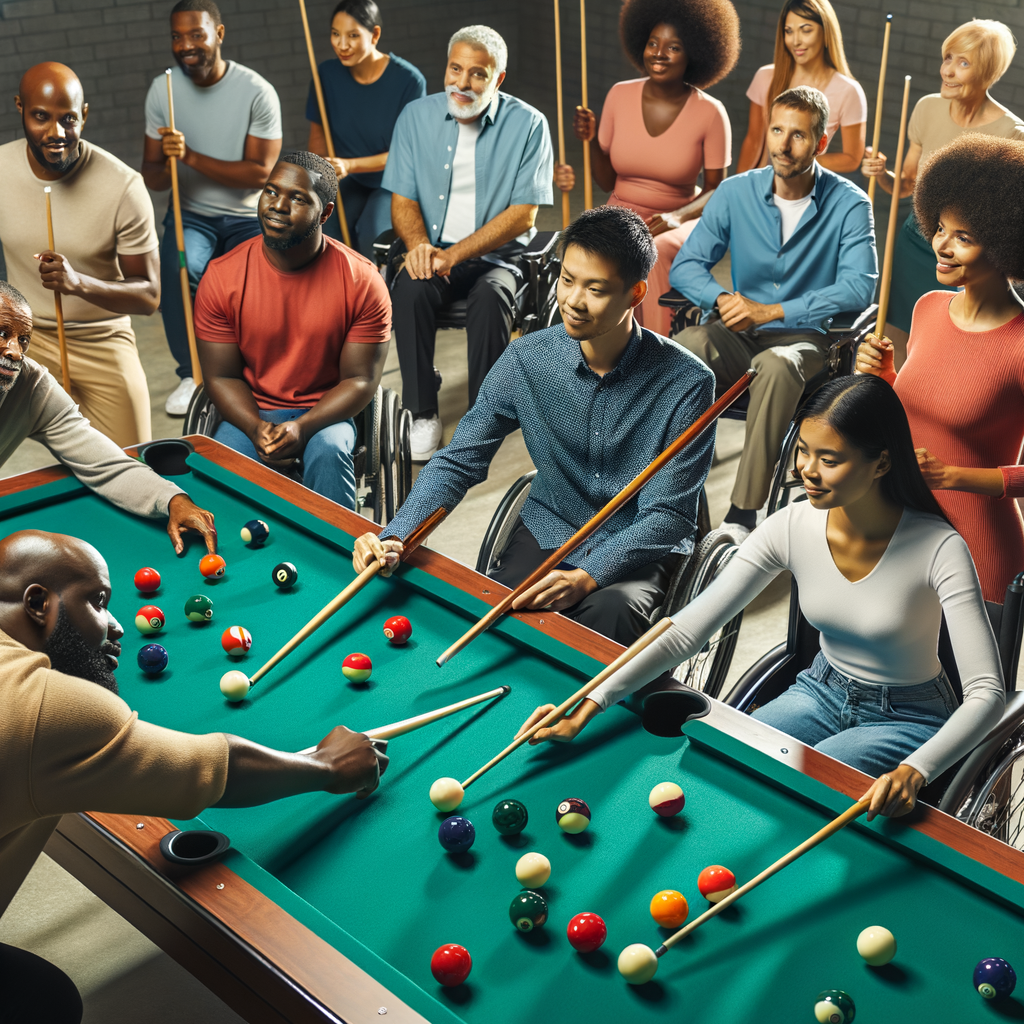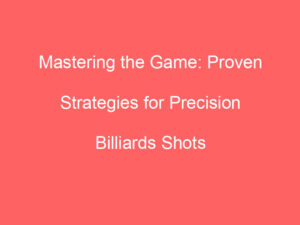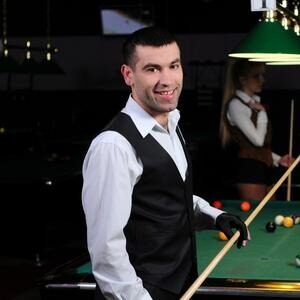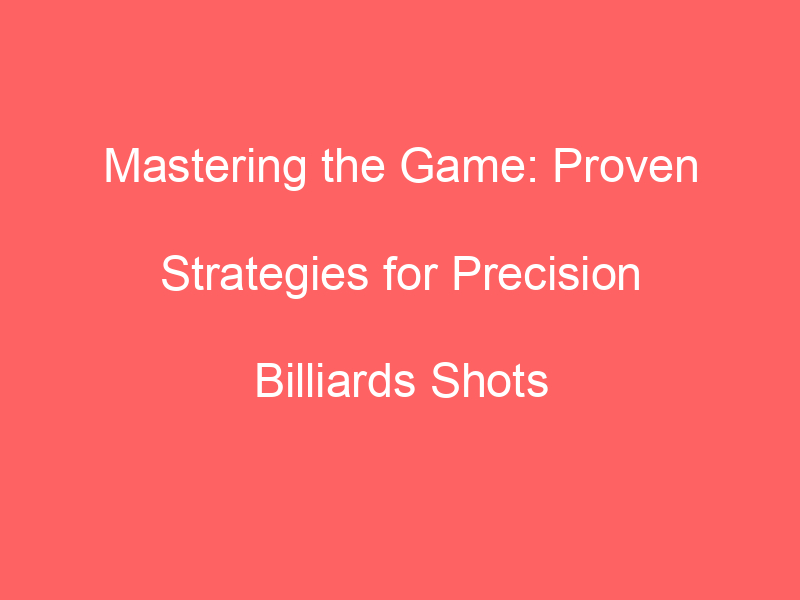
Introduction to Adaptive Billiards Strategies
Billiards, a game of skill and precision, is enjoyed by many people around the world. However, not everyone has the same physical abilities, which can make playing traditional billiards challenging. This is where adaptive billiards strategies come into play. These strategies allow individuals of all abilities to enjoy the game, leveling the playing field and making the game more inclusive.
-
- Understanding the need for adaptive strategies in billiards
Adaptive strategies in billiards are essential because they allow individuals with different physical abilities to participate in the game. These strategies may involve the use of special equipment, modified rules, or alternative techniques. For instance, someone who has limited mobility in their arms might use a cue stick with an extended reach or a mechanical bridge. This allows them to make shots that would otherwise be difficult or impossible.
Adaptive strategies are not just about making the game playable for individuals with different abilities. They also help to make the game more enjoyable and competitive. By leveling the playing field, these strategies allow everyone to participate fully in the game, regardless of their physical abilities.
-
- Benefits of inclusive sports for all abilities
Inclusive sports, like adaptive billiards, have numerous benefits. They promote physical activity, which is essential for health and well-being. They also provide opportunities for social interaction, helping to build friendships and community.
Moreover, inclusive sports can boost self-esteem and confidence. When individuals with different abilities are able to participate fully in a sport, they can experience a sense of accomplishment and pride. This can have a positive impact on their overall mental health and well-being.
In conclusion, adaptive billiards strategies are essential for making the game accessible and enjoyable for all. Whether it’s through the use of special equipment, modified rules, or alternative techniques, these strategies level the playing field and promote inclusivity. So, let’s embrace these strategies and enjoy the game of billiards together!
Billiards for Different Abilities
Billiards is a game that can be enjoyed by people of all abilities. With the right equipment and strategies, even those with physical disabilities can participate and excel in this exciting sport.
Adapting to Physical Disabilities
Adapting to physical disabilities in billiards involves two primary aspects: using adaptive billiards equipment and employing specific techniques and strategies. Let’s delve into these aspects.
-
- Adaptive Billiards Equipment for Physical Disabilities
Adaptive billiards equipment is designed to help players with physical disabilities participate in the game more easily. For instance, cue extensions can be used by players with limited reach. There are also special bridges and rests that can assist players who have difficulty bending or maintaining a steady hand. Wheelchair-accessible pool tables with lower heights are also available to accommodate players who use wheelchairs.
-
- Techniques and Strategies for Players with Physical Disabilities
Along with adaptive equipment, certain techniques and strategies can help players with physical disabilities excel in billiards. For example, players with limited mobility can focus on improving their shot planning and precision. This involves carefully analyzing the table layout and planning shots in advance to minimize the need for extensive movement around the table.
Another strategy is to practice controlling the cue ball’s speed and direction. This skill can help players position the cue ball for their next shot, reducing the need to move around the table. Additionally, players can develop a stable and comfortable stance that suits their physical condition to ensure accurate and consistent shots.
In conclusion, physical disabilities need not be a barrier to enjoying and excelling in billiards. With adaptive equipment and the right strategies, everyone can participate in this engaging sport.
Adapting to Visual Impairments
Playing billiards can be a fun and challenging activity. But for those with visual impairments, it may seem daunting. However, with the right techniques and strategies, as well as the use of assistive technology, billiards can be an enjoyable and accessible game for everyone.
-
- Techniques and Strategies for Players with Visual Impairments
There are several techniques and strategies that can help players with visual impairments enjoy the game of billiards. One of the most important is to rely on touch and feel. This means understanding the weight and balance of the cue, feeling the edges of the table, and even using your fingers to guide the cue ball.
Another strategy is to use sound. The sound of the cue ball hitting the other balls can provide a lot of information about the success of a shot. Additionally, players can use the sound of the balls hitting the sides of the table to help orient themselves.
Finally, players with visual impairments can use their memory and spatial awareness. This involves remembering where the balls are on the table and using this information to plan their shots.
-
- Use of Assistive Technology in Billiards for Visually Impaired Players
Assistive technology can also play a crucial role in making billiards more accessible for players with visual impairments. For instance, there are tactile markers that can be placed on the table to help players feel the layout of the balls. There are also cue guides that can help players aim their shots more accurately.
Another useful piece of technology is a talking billiards app. This app can provide auditory feedback about the position of the balls on the table, helping players plan their shots. It can also provide feedback about the success of a shot, helping players improve their game.
In conclusion, with the right techniques, strategies, and assistive technology, billiards can be a fun and accessible game for players with visual impairments. So, don’t let a visual impairment stop you from enjoying the game of billiards. With a little practice and the right tools, you can become a skilled player.
Inclusive Billiards Techniques
Billiards is a game that everyone can enjoy, regardless of their abilities. The key to making this possible is inclusivity. In this section, we will explore how to create an inclusive environment in billiards and discuss some rule modifications that can make the game more accessible to all players.
-
- Creating an inclusive environment in billiards
Creating an inclusive environment in billiards starts with the physical setup of the billiards area. Ensure that the billiards table and surrounding area are accessible to everyone, including those using mobility aids. The height of the table, the space around it, and the accessibility of equipment should all be considered.
Another important aspect is the social environment. Encourage all players to respect each other’s abilities and differences. This can be achieved by setting clear expectations about behavior and promoting a culture of inclusivity. Remember, the goal is for everyone to enjoy the game.
-
- Rules modifications for inclusive play
Modifying the rules can make billiards more inclusive. For example, you might allow players with physical disabilities to use aids or assistance when taking their shots. This could include using a bridge or even a helper to position the cue.
Another modification could be to adjust the scoring system to level the playing field. For instance, players with less experience or physical limitations could be given a head start in points. The key is to be flexible and open to changes that make the game more enjoyable for everyone.
In conclusion, creating an inclusive environment in billiards and modifying the rules for inclusive play can make the game more accessible and enjoyable for all players. Remember, the goal is not just to win, but to have fun and promote a sense of community and belonging.
Adaptive Sports Strategies
Adapting sports to be more inclusive is not just about modifying the rules. It’s also about changing our attitudes and perceptions. Stay tuned for our next section where we will discuss adaptive sports strategies in more detail.
Adaptive Sports Strategies
Adaptive sports strategies are essential for making sports accessible and enjoyable for everyone, regardless of their abilities. These strategies are not just about physical adaptations, but also about changing the way we think about sports. Let’s delve into the general adaptive strategies used in sports.
General Adaptive Strategies in Sports
Adaptive strategies in sports are methods and techniques used to modify traditional sports rules, equipment, or play methods to accommodate athletes of all abilities. These strategies ensure everyone can participate and compete in sports, regardless of their physical or cognitive abilities.
-
- Importance of adaptive strategies in sports
Adaptive strategies in sports are crucial for several reasons. They promote inclusivity, ensuring that everyone, regardless of their abilities, can participate in sports. They also foster a sense of community, as they bring together people of diverse abilities to engage in a common activity. Moreover, adaptive strategies can help improve the physical and mental health of individuals with disabilities, as they provide an opportunity for exercise and social interaction.
-
- Examples of adaptive strategies in other sports
There are numerous examples of adaptive strategies in various sports. For instance, in basketball, athletes with mobility impairments can participate in wheelchair basketball, where the rules and equipment have been adapted to accommodate wheelchairs. In swimming, athletes with visual impairments may use tappers to alert them when they are approaching the end of the pool. In athletics, runners with visual impairments can compete with the help of guide runners. These examples illustrate how adaptive strategies can make sports accessible to everyone.
Applying General Adaptive Strategies to Billiards
Adaptive strategies are not just for traditional sports. They can also be applied to games like billiards to make them more inclusive and accessible. Let’s explore how we can adapt general sports strategies to billiards and look at a case study that demonstrates the successful use of these strategies.
- Adapting General Sports Strategies to Billiards
Adapting general sports strategies to billiards involves understanding the unique needs of each player and modifying the game accordingly. This could mean adjusting the height of the pool table for a player in a wheelchair or using brightly colored balls for a player with visual impairments. The key is to ensure that everyone can participate and enjoy the game, regardless of their abilities.
For example, in basketball, players with different abilities might use a lower hoop or a lighter ball. Similarly, in billiards, we could use a lighter cue or a smaller table. The idea is to make the game more accessible while still maintaining its competitive nature.
| Adaptive Strategy | Application in Billiards |
|---|---|
| Lowering the height | Adjusting the height of the pool table |
| Using lighter equipment | Using a lighter cue |
| Modifying the size | Using a smaller table |
- Case Study: Successful Use of Adaptive Strategies in Billiards
Let’s look at a real-life example of how adaptive strategies can be successfully applied in billiards. The American Poolplayers Association (APA) has been a pioneer in promoting adaptive billiards. They have introduced several adaptive strategies, such as allowing players to use assistive devices like cue holders and bridges, and even permitting players to shoot from a seated position.
These adaptations have made a significant difference. In fact, several players with disabilities have been able to compete at the national level, demonstrating that adaptive strategies can level the playing field in billiards.
In conclusion, adaptive strategies are a powerful tool for making billiards more inclusive. By adjusting the game to meet the needs of each player, we can ensure that everyone has the opportunity to participate and enjoy this wonderful game.
Billiards Techniques for Disabilities
Playing billiards is a fun and engaging activity that can be enjoyed by everyone, regardless of physical abilities. This section will focus on the techniques that wheelchair users can adapt to play billiards successfully.
Techniques for Wheelchair Users
Wheelchair users can enjoy the game of billiards just as much as anyone else. With a few modifications and adaptive techniques, they can play the game effectively and competitively.
-
- Adapting billiards techniques for wheelchair users
Adapting billiards techniques for wheelchair users involves a few key considerations. First, the height of the pool table may need to be adjusted to a comfortable level for the player. This can be done by using a specially designed, adjustable pool table. Second, the player may need to use a bridge or a cue extender to reach the balls on the table. This allows the player to make accurate shots without straining.
Another important aspect is positioning. Wheelchair users need to learn how to position their wheelchairs correctly around the table to get the best shot. This involves understanding angles and distances, and it may take some practice to get it right.
-
- Case study: Successful wheelchair users in billiards
There are many successful wheelchair users in the world of billiards who serve as an inspiration. One such player is Fred Dinsmore from Ireland. Despite his physical disability, Fred has won numerous international titles in wheelchair billiards, including the European Championship and the World Championship.
Fred’s success in billiards is a testament to the fact that physical disabilities do not have to be a barrier to enjoying and excelling in this game. His story serves as an inspiration to other wheelchair users who wish to take up billiards.
In conclusion, with the right adaptations and techniques, wheelchair users can enjoy and excel in the game of billiards. It’s all about finding the right equipment, learning the correct positioning, and practicing to perfect the shots.
Techniques for Players with Limited Mobility
Billiards is a game that can be enjoyed by everyone, regardless of physical abilities. For players with limited mobility, there are several techniques that can be adapted to ensure they can still enjoy the game and compete effectively. Let’s explore some of these techniques and also look at some successful players who have overcome their mobility challenges to excel in billiards.
- Adapting billiards techniques for players with limited mobility
Adapting billiards techniques for players with limited mobility involves a combination of equipment modifications and strategy adjustments. Here are some tips:
- Use of adaptive equipment: Specialized cue sticks with longer lengths or extensions can help players reach across the table without straining. Some players may also find it beneficial to use a bridge, a device that supports the cue stick, to make shots more comfortable.
- Positioning and movement: Players with limited mobility may need to adopt different stances or positions to play their shots. This could involve sitting or using supportive devices. It’s important to find a comfortable position that allows for the best possible shot.
- Strategy adjustments: Players may need to focus more on strategy, planning their shots carefully to minimize the need for difficult movements.
- Case study: Successful players with limited mobility in billiards
There are many successful billiards players who have not let their limited mobility stop them from excelling in the game. One such player is Fred Dinsmore from Ireland, a world champion in wheelchair billiards. Despite his mobility challenges, Dinsmore has won numerous international titles and is a testament to the fact that billiards is a game of skill and strategy, not just physical prowess.
Another inspiring player is Jeanette Lee, known as “The Black Widow,” who has battled scoliosis since childhood. Despite undergoing multiple surgeries and often playing in pain, Lee has won numerous professional titles and is considered one of the greatest female players in the history of billiards.
These players demonstrate that with the right techniques and determination, anyone can enjoy and excel in the game of billiards, regardless of their physical abilities.
In conclusion, billiards is a game that can be adapted to suit players of all abilities. With the right techniques and equipment, players with limited mobility can not only participate in the game but also compete at a high level. As the case studies of Dinsmore and Lee show, billiards is a game where skill and strategy can overcome physical challenges.
Conclusion: Adaptive Billiards for All
In this blog post, we’ve explored the fascinating world of adaptive billiards, a sport that is as inclusive as it is challenging. We’ve delved into the strategies and techniques that make it accessible to people of all abilities, and we’ve seen how these adaptations are changing the face of sports as we know it.
- Recap of adaptive strategies and techniques in billiards
Throughout this post, we’ve highlighted a variety of adaptive strategies and techniques in billiards. These include modified cue sticks, specialized bridges, and wheelchair-friendly tables. We’ve also discussed the importance of training and practice, and how these elements can help players of all abilities improve their game.
One of the key insights we’ve gleaned is that adaptive billiards is not just about physical adaptations. It’s also about fostering an inclusive mindset, where everyone is welcomed and encouraged to participate, regardless of their abilities.
- The future of inclusive sports and billiards
Looking ahead, the future of inclusive sports and billiards is bright. More and more people are recognizing the value of sports for all, and this is leading to increased investment and innovation in the field. We can expect to see more adaptive equipment and techniques being developed, and more opportunities for people of all abilities to participate in billiards and other sports.
As we move forward, let’s remember the words of legendary billiards player Willie Mosconi: “Billiards is a game that can be played by anyone, regardless of age, size, or physical ability. It’s a game of skill, strategy, and precision, and it’s a game that can bring people together in a spirit of friendly competition.”
With adaptive billiards, we’re taking this sentiment to heart, and making the game truly accessible to all.














